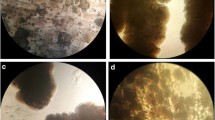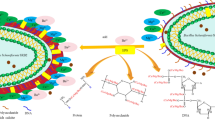Abstract
The ability of Halomonas maura to bioprecipitate carbonate and sulphate crystals in solid media at different manganese concentrations has been demonstrated in this study for the first time. The precipitated minerals were studied by X-ray diffraction, scanning and transmission electron microscopy, and energy-dispersive X-ray spectroscopy. The precipitated minerals were different based on the manganese concentration present in the medium and the incubation time. In the absence of manganese, H. maura formed pseudokutnahorite crystals; in the presence of manganese, the concentration in the culture medium determined the precipitation carbonates, such as rhodochrosite and dolomites. However, in the presence of low concentrations of manganese chloride (MnCl2) (5 g/l), kutnohorite crystals were also formed. Finally, when H. maura was grown in the presence of manganese, small amounts of sulphate crystals (such as bassanite and gypsum) were detected. Our study of the precipitated minerals showed an active role of H. maura in the biomineralisation process, but the geochemical conditions, and the manganese concentrations in particular, were clearly influential.



Similar content being viewed by others
References
Aloisi G, Gloter A, Krüger M et al (2006) Nucleation of calcium carbonate on bacterial nanoglobules. Geology 34:1017–1020
Arias S, del Moral A, Ferrer MR et al (2003) Mauran, an exopolysaccharide produced by the halophilic bacterium Halomonas maura, with a novel composition and interesting properties for biotechnology. Extremophiles 7:319–326
Bosak T, Souza-Egipsy V, Newman D (2004) A laboratory model of abiotic peloid formation. Geobiology 2:189–198
Bouchotroch S, Quesada E, del Moral A et al (2001) Halomonas maura sp. nov., a novel moderately halophilic, exopolysaccharide-producing bacterium. Int J Syst Evol Microbiol 51:1625–1632
Cailleau G, Braissant O, Dupraz C et al (2005) Biologically induced accumulations of CaCO3 in orthox soils of Biga, Ivory Coast. Catena 59:1–17
Calvert S, Pedersen T (1996) Sedimentary geochemistry of manganese; implications for the environment of formation of manganiferous black shales. Econ Geol 91:36–47
Chekroun KB, Rodríguez-Navarro C, González-Muñoz MT et al (2004) Precipitation and growth morphology of calcium carbonate induced by Myxococcus xanthus: implications for recognition of bacterial carbonates. J Sediment Res 74:868–876
Deelman J (2003) Low-temperature formation of dolomite and magnesite. Compact Disc Publications, Eindhoven
Delgado G, Delgado R, Parraga J et al (2008) Precipitation of carbonates and phosphates by bacteria in extract solutions from a semi-arid saline soil. Influence of Ca2+ and Mg2+ concentrations and Mg2+/Ca2+ molar ratio in biomineralization. Geomicrobiol J 25:1–13
Ehrlich HL, Newman DK, Kappler A (2015) Ehrlich’s geomicrobiology. CRC Press, Boca Raton
Lee JH, Kennedy DW, Dohnalkova A et al (2011) Manganese sulfide formation via concomitant microbial manganese oxide and thiosulfate reduction. Environ Microbiol 13:3275–3288
Martin JD (2004) Using XPowder: a software package for Powder X-ray diffraction analysis. DL GR 1001:105
Párraga J, Rivadeneyra M, Delgado R et al (1998) Study of biomineral formation by bacteria from soil solution equilibria. React Funct Polymers 36:265–271
Peckmann J, Paul J, Thiel V (1999) Bacterially mediated formation of diagenetic aragonite and native sulfur in Zechstein carbonates (Upper Permian, Central Germany). Sediment Geol 126:205–222
Politi Y, Arad T, Klein E et al (2004) Sea urchin spine calcite forms via a transient amorphous calcium carbonate phase. Science 306:1161–1164
Rivadeneyra MA, Párraga J, Delgado R et al (2004) Biomineralization of carbonates by Halobacillus trueperi in solid and liquid media with different salinities. FEMS Microbiol Ecol 48:39–46
Rivadeneyra MA, Martín-Algarra A, Sánchez-Navas A, Martín-Ramos D (2006) Carbonate and phosphate precipitation by Chromohalobacter marismortui. Geomicrobiol J 23:1–13
Rivadeneyra MA, Martín-Algarra A, Sánchez-Román M et al (2010) Amorphous Ca-phosphate precursors for Ca-carbonate biominerals mediated by Chromohalobacter marismortui. ISME J 4:922–932
Rivadeneyra A, Rivadeneyra MA, Escamilla CV et al (2016) The influence of salt concentration on the precipitation of magnesium calcite and calcium dolomite by Halomonas anticariensis. Expert Opin Environ Biol 5:2
Sánchez-Román M, Rivadeneyra MA, Vasconcelos C, McKenzie JA (2007) Biomineralization of carbonate and phosphate by moderately halophilic bacteria. FEMS Microbiol Ecol 61:273–284
Silva-Castro GA, Uad I, Rivadeneyra A et al (2013) Carbonate precipitation of bacterial strains isolated from sediments and seawater: formation mechanisms. Geomicrobiol J 30:840–850
Silva-Castro GA, Uad I, Gonzalez-Martinez A et al (2015) Bioprecipitation of calcium carbonate crystals by bacteria isolated from saline environments grown in culture media amended with seawater and real brine. BioMed Res Int 2015:Article ID 816102
Subow NN (1931) Oceanographical tables. USSR Oceanographic Institute Hydrometeorological Commission, Moscow, pp 208
Torres AR, Martinez-Toledo M, Gonzalez-Martinez A et al (2013) Precipitation of carbonates by bacteria isolated from wastewater samples collected in a conventional wastewater treatment plant. Int J Environ Sci Technol 10:141–150
Vali H, Koster H (1986) Expanding behaviour, structural disorder, regular and random irregular interstratification of 2:1 layer-silicates studied by high-resolution images of transmission electron microscopy. Clay Miner 21:827–859
Author information
Authors and Affiliations
Corresponding author
Additional information
Communicated by H. Atomi.
Rights and permissions
About this article
Cite this article
Rivadeneyra, A., Gonzalez-Martinez, A., Portela, G.R. et al. Biomineralisation of carbonate and sulphate by the halophilic bacterium Halomonas maura at different manganese concentrations. Extremophiles 21, 1049–1056 (2017). https://doi.org/10.1007/s00792-017-0965-8
Received:
Accepted:
Published:
Issue Date:
DOI: https://doi.org/10.1007/s00792-017-0965-8




